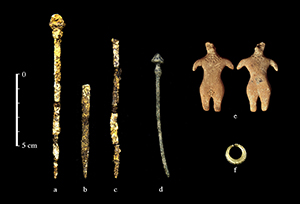Crossref Citations
This article has been cited by the following publications. This list is generated based on data provided by
Crossref.
Olivieri, Luca Maria
Marzaioli, Fabio
Passariello, Isabella
Iori, Elisa
Micheli, Roberto
Terrasi, Filippo
Vidale, Massimo
and
D'Onofrio, Antonio
2019.
A new revised chronology and cultural sequence of the Swat valley, Khyber Pakhtunkhwa (Pakistan) in the light of current excavations at Barikot (Bir-kot-ghwandai).
Nuclear Instruments and Methods in Physics Research Section B: Beam Interactions with Materials and Atoms,
Vol. 456,
Issue. ,
p.
148.
Narasimhan, Vagheesh M.
Patterson, Nick
Moorjani, Priya
Rohland, Nadin
Bernardos, Rebecca
Mallick, Swapan
Lazaridis, Iosif
Nakatsuka, Nathan
Olalde, Iñigo
Lipson, Mark
Kim, Alexander M.
Olivieri, Luca M.
Coppa, Alfredo
Vidale, Massimo
Mallory, James
Moiseyev, Vyacheslav
Kitov, Egor
Monge, Janet
Adamski, Nicole
Alex, Neel
Broomandkhoshbacht, Nasreen
Candilio, Francesca
Callan, Kimberly
Cheronet, Olivia
Culleton, Brendan J.
Ferry, Matthew
Fernandes, Daniel
Freilich, Suzanne
Gamarra, Beatriz
Gaudio, Daniel
Hajdinjak, Mateja
Harney, Éadaoin
Harper, Thomas K.
Keating, Denise
Lawson, Ann Marie
Mah, Matthew
Mandl, Kirsten
Michel, Megan
Novak, Mario
Oppenheimer, Jonas
Rai, Niraj
Sirak, Kendra
Slon, Viviane
Stewardson, Kristin
Zalzala, Fatma
Zhang, Zhao
Akhatov, Gaziz
Bagashev, Anatoly N.
Bagnera, Alessandra
Baitanayev, Bauryzhan
Bendezu-Sarmiento, Julio
Bissembaev, Arman A.
Bonora, Gian Luca
Chargynov, Temirlan T.
Chikisheva, Tatiana
Dashkovskiy, Petr K.
Derevianko, Anatoly
Dobeš, Miroslav
Douka, Katerina
Dubova, Nadezhda
Duisengali, Meiram N.
Enshin, Dmitry
Epimakhov, Andrey
Fribus, Alexey V.
Fuller, Dorian
Goryachev, Alexander
Gromov, Andrey
Grushin, Sergey P.
Hanks, Bryan
Judd, Margaret
Kazizov, Erlan
Khokhlov, Aleksander
Krygin, Aleksander P.
Kupriyanova, Elena
Kuznetsov, Pavel
Luiselli, Donata
Maksudov, Farhod
Mamedov, Aslan M.
Mamirov, Talgat B.
Meiklejohn, Christopher
Merrett, Deborah C.
Micheli, Roberto
Mochalov, Oleg
Mustafokulov, Samariddin
Nayak, Ayushi
Pettener, Davide
Potts, Richard
Razhev, Dmitry
Rykun, Marina
Sarno, Stefania
Savenkova, Tatyana M.
Sikhymbaeva, Kulyan
Slepchenko, Sergey M.
Soltobaev, Oroz A.
Stepanova, Nadezhda
Svyatko, Svetlana
Tabaldiev, Kubatbek
Teschler-Nicola, Maria
Tishkin, Alexey A.
Tkachev, Vitaly V.
Vasilyev, Sergey
Velemínský, Petr
Voyakin, Dmitriy
Yermolayeva, Antonina
Zahir, Muhammad
Zubkov, Valery S.
Zubova, Alisa
Shinde, Vasant S.
Lalueza-Fox, Carles
Meyer, Matthias
Anthony, David
Boivin, Nicole
Thangaraj, Kumarasamy
Kennett, Douglas J.
Frachetti, Michael
Pinhasi, Ron
and
Reich, David
2019.
The formation of human populations in South and Central Asia.
Science,
Vol. 365,
Issue. 6457,
Briceño, Tarcicio Gaitán
Fandiño, Emigdio Mendoza
and
Rojo, Piedad Gañán
2021.
The destruction of the golden calf (Ex 32:20): A materials science perspective.
Verbum et Ecclesia,
Vol. 42,
Issue. 1,
Iori, Elisa
2024.
Handbook on Urban History of Early India.
p.
173.



